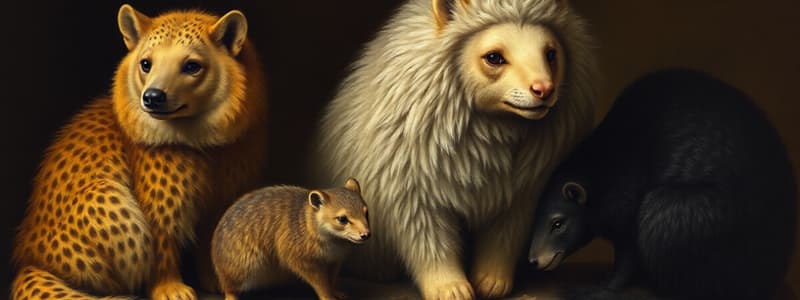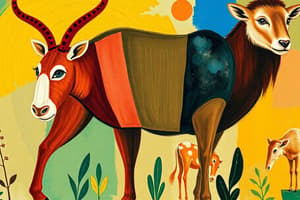Podcast
Questions and Answers
What substance primarily composes rhinoceros horns?
What substance primarily composes rhinoceros horns?
- Keratinised filaments (correct)
- Bone tissue
- Cartilage
- Collagen fibers
Which statement about mammalian endothermy is true?
Which statement about mammalian endothermy is true?
- All mammals are exothermic.
- Mammals require less food energy than reptiles.
- Mammals need to eat more food than reptiles weight for weight. (correct)
- Endothermy is unique to mammals.
What is the primary function of eccrine sweat glands?
What is the primary function of eccrine sweat glands?
- To produce heat
- To secrete milky fluid
- To cool the skin (correct)
- To enhance hair quality
In humans, where are apocrine glands mainly located?
In humans, where are apocrine glands mainly located?
What differentiates sebaceous glands from other integumentary glands in mammals?
What differentiates sebaceous glands from other integumentary glands in mammals?
What is the primary role of scent glands in mammals?
What is the primary role of scent glands in mammals?
How do mammary glands develop in female mammals?
How do mammary glands develop in female mammals?
Which of the following best characterizes the naked mole rat?
Which of the following best characterizes the naked mole rat?
What characterizes the gestation period of viviparous placental mammals compared to marsupials?
What characterizes the gestation period of viviparous placental mammals compared to marsupials?
Which type of placenta initially supplies nourishment to the embryo in viviparous placental mammals?
Which type of placenta initially supplies nourishment to the embryo in viviparous placental mammals?
Which statement about gestation periods in mammals is true?
Which statement about gestation periods in mammals is true?
What is typically true about the number of young produced by small mammals?
What is typically true about the number of young produced by small mammals?
How does the dependency of young mammals on their mothers benefit their development?
How does the dependency of young mammals on their mothers benefit their development?
What is one advantage of increased brain complexity in mammals?
What is one advantage of increased brain complexity in mammals?
Which of the following statements is false regarding the birth condition of young mammals?
Which of the following statements is false regarding the birth condition of young mammals?
Which type of social structure do some mammals exhibit?
Which type of social structure do some mammals exhibit?
What additional role do mammary glands serve in humans beyond feeding the young?
What additional role do mammary glands serve in humans beyond feeding the young?
How do most mammals secrete milk from their mammary glands?
How do most mammals secrete milk from their mammary glands?
Which group of mammals can be categorized as opportunistic feeders?
Which group of mammals can be categorized as opportunistic feeders?
What is the term used for mammals that exhibit differentiated dentition?
What is the term used for mammals that exhibit differentiated dentition?
Which type of teeth is primarily used for biting and snipping?
Which type of teeth is primarily used for biting and snipping?
Which trophic category do shrews and moles belong to?
Which trophic category do shrews and moles belong to?
What is a key characteristic of herbivores in terms of their diet?
What is a key characteristic of herbivores in terms of their diet?
Which of the following mammals belongs to the category of gnawers?
Which of the following mammals belongs to the category of gnawers?
What term was previously used to describe pelycosaurs and therapsids?
What term was previously used to describe pelycosaurs and therapsids?
Which feature is NOT associated with cynodont evolution supporting a high metabolic rate?
Which feature is NOT associated with cynodont evolution supporting a high metabolic rate?
What adaptation allowed the earliest mammals to suckle while breathing?
What adaptation allowed the earliest mammals to suckle while breathing?
What characteristic did early mammals possess compared to modern placental mammals?
What characteristic did early mammals possess compared to modern placental mammals?
What happened to the main lower jawbone during evolution from therapsid to mammal?
What happened to the main lower jawbone during evolution from therapsid to mammal?
What was a likely trigger for the synapsids' evolution into early mammals?
What was a likely trigger for the synapsids' evolution into early mammals?
What role did hair play for early mammals?
What role did hair play for early mammals?
Following the Permian extinction, which group began to dominate during the Mesozoic Era?
Following the Permian extinction, which group began to dominate during the Mesozoic Era?
What is the approximate number of mammal species compared to fish species?
What is the approximate number of mammal species compared to fish species?
Which mammal has the smallest known weight?
Which mammal has the smallest known weight?
What major factor has influenced mammals more than any other animal group?
What major factor has influenced mammals more than any other animal group?
What is the most numerous domestic animal globally?
What is the most numerous domestic animal globally?
What is one consequence of introducing alien mammals into new habitats?
What is one consequence of introducing alien mammals into new habitats?
Which mammal species was officially exterminated in a policy affecting Native Americans?
Which mammal species was officially exterminated in a policy affecting Native Americans?
What has contributed to the potential collapse of the whaling industry?
What has contributed to the potential collapse of the whaling industry?
What is a current impact of the ever-growing human population on mammals?
What is a current impact of the ever-growing human population on mammals?
Flashcards are hidden until you start studying
Study Notes
Overview of Mammals
- Mammals are an incredibly diverse group with approximately 4,600 species, significantly smaller than birds (9,000 species), fish (24,600 species), and insects (800,000 species).
- They inhabit nearly every environment on Earth and exhibit a wide range of adaptations, size, and form.
Size Variation
- Size varies dramatically; examples include the Kitti's hog-nosed bat at 1.5 grams and blue whales exceeding 130 tonnes.
Human Interaction
- Mammals have been heavily influenced by humans, who have domesticated many for food, clothing, and companionship.
- In 2005, global statistics indicated:
- 1.3 billion domestic cattle
- 960 million pigs
- 54 million horses
- 808 million goats
- 1 billion sheep
- Most numerous is the chicken with 16 billion individuals.
Environmental Impact and Extinction
- Human activity has led to the extinction of several mammals, such as the aurochs and the Tasmanian wolf.
- Over-exploitation, such as in the whaling industry, poses a threat to mammalian populations and resources.
- Habitat destruction due to growing human populations continues to impact mammal survival.
Evolutionary History
- Early mammal lineages, such as therapsids, adapted post-Permian extinction, showcasing features for high metabolic rates.
- Critical adaptations in mammals include:
- Increased jaw musculature for strong bites.
- Skeletal changes enhancing mobility.
- Turbinate bones aiding heat retention.
Temperature Regulation
- Most mammals are endothermic (warm-blooded) and utilize hair for insulation; a few exceptions include the naked mole rat, which is exothermic.
Integumentary Glands
- Mammals possess a diverse range of integumentary glands, including sweat, scent, sebaceous, and mammary glands, which serve various purposes like cooling, communication, and reproduction.
Feeding and Diet
- Dentition is closely linked to diet, providing insights into feeding habits.
- Most mammals have two sets of teeth (deciduous and permanent) and are heterodonts, signifying specialized adaptations for different diets.
- Mammals can be classified as:
- Insectivores
- Herbivores
- Carnivores
- Omnivores
Reproductive Strategies
- Eutherians (placental mammals) have significant reproductive investment focused on longer gestation periods.
- Gestation lengths vary greatly by species, with larger animals generally having longer gestation.
- Species such as elephants may produce four calves over their lifetimes, signifying reproductive strategy diversity.
Social Behavior and Learning
- Maternal care allows young mammals to learn from adults, enhancing their adaptability and survival skills.
- Some mammals are solitary, while others form social groups for protection and social learning.
- Behavioral flexibility and increased brain complexity in mammals are key to their evolutionary success, allowing for efficient responses to environmental changes.
Studying That Suits You
Use AI to generate personalized quizzes and flashcards to suit your learning preferences.




